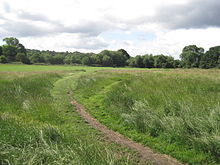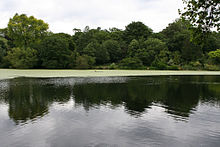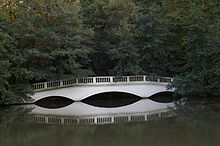
Hampstead Heath
Background Information
SOS Children has tried to make Wikipedia content more accessible by this schools selection. To compare sponsorship charities this is the best sponsorship link.
Coordinates: 51°33′47″N 0°10′6″W Hampstead Heath (locally known as "the Heath") is a large, ancient London park, covering 320 hectares (790 acres). This grassy public space sits astride a sandy ridge, one of the highest points in London, running from Hampstead to Highgate, which rests on a band of London Clay. The Heath is rambling and hilly, embracing ponds, recent and ancient woodlands, a lido, playgrounds, and a training track, and it adjoins the stately home of Kenwood House and its grounds. The SE part of the Heath is Parliament Hill, whose view over London is protected by law.
The Heath has long been a popular place for Londoners to walk and take the air. Running along its eastern perimeter are a chain of ponds - including three open-air public swimming pools - which were originally reservoirs for drinking water from the River Fleet. The Heath is a Site of Metropolitan Importance for Nature Conservation, and part of Kenwood is a Site of Special Scientific Interest. Lakeside concerts are held there in summer. The Heath is managed by the City of London Corporation, and lies mostly within the London Borough of Camden with the adjoining Hampstead Heath Extension and Golders Hill Park in the London Borough of Barnet.
History
The Heath first entered the history books in 986 when Ethelred the Unready granted one of his servants five hides of land at "Hemstede". This same land is later recorded in the Domesday Book of 1086 as held by the monastery of St. Peter's at Westminster Abbey, and by then is known as the "Manor of Hampstead". Westminster held the land until 1133 when control of part of the manor was released to one Richard de Balta; then during Henry II's reign the whole of the manor became privately owned by Alexander de Barentyn, the King's butler. Manorial rights to the land remained in private hands until the 1940s when they lapsed under Sir Spencer Pocklington Maryon Wilson, though the estate itself was passed on to Shane Gough, 5th Viscount Gough.
Over time, plots of land in the manor were sold off for building, particularly in the early 19th century, though the Heath remained mainly common land. The main part of the Heath was acquired for the people by the Metropolitan Board of Works. Parliament Hill was purchased for the public for £300,000 and added to the park in 1888. Golders Hill was added in 1898 and Kenwood House and grounds were added in 1928.
From 1808 to 1814 Hampstead Heath hosted a station in the shutter telegraph chain which connected the Admiralty in London to its naval ships in the port of Great Yarmouth.
The City of London Corporation has managed the Heath since 1989. Before that it was managed by the GLC and before that by the London County Council (LCC).
The City of London proposed to build a new road on the Heath to service their 'Masterplan' developments. The proposal met with protests from local residents and celebrities, and did not proceed.
Geography
The Heath sits astride a sandy ridge that rests on a band of London Clay. It runs from east to west, its highest point being 134 metres (440 ft). As the sand was easily penetrated by rainwater which was then held by the clay, a landscape of swampy hollows, springs and man-made excavations was created. Hampstead Heath contains the largest single area of common land in Greater London, with 144.93 hectares (358.1 acres) of protected commons.
Public transport near the Heath includes London Overground railway stations Hampstead Heath and Gospel Oak and London Underground stations at Hampstead and Belsize Park to the south, Golders Green to the north-west, and Highgate and Archway to the east. Buses serve several roads around the Heath.
Areas of the Heath
The Heath's 320 hectares (790 acres) include a number of distinct areas. "Boudicca's Mound", near the present men's bathing pond, is a tumulus where, according to local legend, Queen Boudicca (Boadicea) was buried after she and 10,000 Iceni warriors were defeated at Battle Bridge. However earlier drawings and paintings of the area show no mound other than a 17th century windmill.
In the south-east of the Heath, on the southern slopes of Parliament Hill, is the Gospel Oak Lido open air swimming pool, with a running track and fitness area to its north.
Wildlife
Hampstead Heath is an important refuge for wildlife, including muntjac deer, grass snakes, foxes, rabbits, slow worms, squirrels, terrapins and frogs.
Common kingfishers, jackdaws and ring-necked parakeets, pipistrelles and Daubenton's bats may be seen over the ponds.
Highgate and Hampstead Ponds
There are over 25 ponds on Hampstead Heath, mostly collected in two distinct areas. On the east (Highgate) side is a series of eight former reservoirs (known as Highgate Ponds) originally dug in the 17th and 18th centuries. These include two single-sex swimming pools (the men's and ladies' bathing ponds), a model boating pond, a wildlife reserve pond and a fishing lake.
In the south-west corner of the Heath, towards South End Green, are three further ponds (known as Hampstead Ponds), one of which is the 'mixed pond', where both sexes may swim. These ponds are the result of the damming in 1777 of Hampstead Brook, one of the sources of the Fleet River, by the Hampstead Water Company which had been formed in 1692 to meet London's growing water demands.
In 2004 the City of London Corporation, which manages the Heath, tried to close the ponds on the grounds that they were an unsustainable expense and posed a health risk to swimmers. The swimmers challenged this and won in the High Court. To defray costs, the Corporation introduced a charge for swimmers of £2 per session, £1 for concessions. There was some opposition to this and some of the ticket machines were vandalized.
In January 2011 the City of London announced a scheme which it says will improve the safety of the dams in the event of a very rare storm which it says may happen once every 10,000 years.
Caen Wood Towers
To the north east of the Heath is a derelict site within the conservation area comprising the grounds and mansion of the former Caen Wood Towers (renamed Athlone House in 1972). This historic building, currently in disrepair, was built in 1872 for Edward Brooke, aniline dye manufacturer (architect, Edward Salomons). In 1942 the building was taken for war service by the Royal Air Force and was used to house the RAF Intelligence School, although the 'official' line was that it was a convalescence hospital. The Operational Record (Form 540) of RAF Station Highgate (currently in the National Archives, Kew) was declassified in the late 1990s and shows the true role of this building in wartime service. The building sustained 2 near misses from V-1 flying bombs in late 1944, causing damage and injuries to staff. The RAF Intelligence School remained in Caen Wood Towers until 1948, when the building was handed over to the Ministry of Health. It was then used as a hospital and finally a post-operative recovery lodge, before falling into disrepair in the 1980s. The NHS sold off this part of their estate in 2004 to a private businessman who is currently redeveloping much of the site; however the House and its gardens fall within the conservation area of Hampstead Heath.
Parliament Hill Fields
Parliament Hill Fields lies on the south and east of the Heath; it officially became part of the Heath in 1888. It contains various sporting facilities including an athletics track, tennis courts and Parliament Hill Lido. Parliament Hill itself is considered by some to be the focal point of the Heath, with the highest part of it known to some as "Kite Hill" due to its popularity with kite flyers. The hill is 98.1 metres (322 ft) high and is notable for the excellent views it provides of the London skyline. The skyscrapers of Canary Wharf and the City of London can be seen, along with St Paul's Cathedral and other landmarks, all in one panorama, parts of which are protected views. The main staff yards for the management of the Heath are located at Parliament Hill Fields.
Kenwood
The area to the north of the Heath is the Kenwood Estate and House - a total area of 50 hectares (120 acres) which is maintained by English Heritage. This became part of the Heath when it was bequeathed to the nation by Lord Iveagh on his death in 1927, and opened to the public in 1928. One third of the estate (Ken Wood and North Wood) is a Site of Special Scientific Interest, designated by Natural England. It is home to many birds and insects and the largest pipistrelle bat roost in London.
The original house dates from the early 17th century. The orangery was added in about 1700.
The popular summer lakeside concerts, which started in 1951, ceased in February 2007 after protests from local residents. However, the return of the concerts was announced in March 2008 after English Heritage agreed a number of changes with Camden Council, notably with regard to noise levels.
The Vale of Health
The Vale of Health is a hamlet (named "Hatchett's Bottom" until 1801) accessed by a lane from East Heath Road; it is surrounded entirely by the Heath.
Extension
The Extension is an open space to the north-west of the main heath. It does not share the history of common and heathland of the rest of the Heath. Instead it was created out of farmland, largely due to the efforts of Henrietta Barnett who went on to found Hampstead Garden Suburb. Its farmland origins can still be seen in the form of old field boundaries, hedgerows and trees.
Golders Hill Park
Golders Hill Park is a formal park adjoining the West Heath. It occupies the site of a large house that was bombed during World War II. It has an expanse of grass, with a formal flower garden a duck pond and a separate water garden that leads to a separate area for deer, near a recently-renovated small zoo. The zoo has donkeys, maras, ring-tailed lemurs, ring-tailed coatis, white-cheeked turacos and European Eagle Owls among other animals.There are also tennis courts, a butterfly house and a putting green.
Unlike the rest of the Heath, Golders Hill Park is fenced in, and is closed at night.
Hampstead Heath Constabulary
The "Hampstead Heath Constabulary" consists of twelve constables, four with trained General Purpose police dogs all licensed to ACPO/Home Office standards. They have been responsible for patrolling the Heath 24 hours a day since 1992.
They are attested as constables under Article 18 of the Ministry of Housing and Local Government Provisional Order Confirmation (Greater London Parks and Open Spaces) Act 1967 before a City of London magistrate. This authorises them to enforce the Hampstead Heath bylaws. They enjoy full powers of a constable in relation to the bylaws and legislation of open spaces when in their jurisdiction of the Heath and have a good working partnership with the Metropolitan Police. All criminal offences on the Heath are investigated by the Metropolitan Police Service, the territorial police force for Greater London.
Activities
The Heath is home to a range of activities, including 16 different sports. It is used by walkers, runners, swimmers and kite-flyers, and is regarded as the home of cross-country running in Britain. There is an annual 5000 metres run through the Heath organised by Umbrella, and until February 2007 Kenwood held a series of popular lakeside concerts.
The West Heath is regarded as one of the most notable night-time cruising grounds in London and this has led to a problem with used condoms and other litter. George Michael has revealed that he cruises on the Heath, an activity he then parodied on the Extras Christmas Special.
Swimming takes place all year round in two of the three natural swimming ponds: the men's pond which opened in the 1890s, and the ladies' pond which opened in 1925. The mixed pond is only open from May to September, though it is the oldest, having been in use since the 1860s.
Facilities include an athletics track, a pétanque pitch, a volleyball court and eight separate children's play areas including an adventure playground.
Culture
The 1968 film "Les Bicyclettes de Belsize" was mainly filmed in Hampstead Village, and Belsize Park.
The 1990 film It, an adaptation of the book by Stephen King, featured a fictional American writer who takes up residence at Hampstead Heath.
The film Scenes of a Sexual Nature (2006) was shot entirely on Hampstead Heath. Notting Hill (1999) featured scenes shot at the Heath, located primarily around Kenwood House.
Hampstead Heath was featured on the television programme Seven Natural Wonders as one of the wonders of the London area, with a focus on Parliament Hill to the south. The episode was presented by Bill Oddie, who lives in nearby Gospel Oak, and watches birds there regularly.
In 2005, Giancarlo Neri's sculpture The Writer, a 9-metre tall table and chair, was exhibited on Hampstead Heath.
Whilst living in London, Karl Marx and his family went to the Heath regularly, as their favourite outing.
John Atkinson Grimshaw, Victorian era painter, painted an elaborate night-time scene of Hampstead Hill in oils. Hampstead Heath also provided the backdrop for the opening scene in Victorian writer Wilkie Collins' novel The Woman in White.
Hampstead Heath forms part of the location for Gilbert Keith Chesterton's fictional story The Blue Cross from The Innocence of Father Brown.
Hampstead Heath forms part of the main location for Will Self's 2006 novel The Book of Dave. Half of the book is set 500 years in the future, when all of London has been submerged by a catastrophic flood, leaving only the hilltops of Hampstead and the Heath as a tiny island - The Island of Ham. The parts of the book set in the present-day also make references to the Heath's high and dry location which would preserve the area in the event of sea level rises over 100m. Self writes, "...the Heath...this peculiar island, a couple of square miles of woodland and meadow set down in the lagoon of the city."
The radio story titled The Strange Case of the Murder in Wax written by Denis Green and Anthony Boucher and broadcast on January 7, 1946, featured a murderer who killed women on Hampstead Heath.
Mrs. Miniver, by Jan Struther, includes a chapter called "On Hampstead Heath", where actions take place.
A crucial event at the beginning of the novel Smiley's People, by John LeCarre (1979), takes place on Hampstead Heath, which is also the site of subsequent investigations. These scenes are also depicted in the BBC mini-series of the same name (1982).
Hampstead Heath is also featured in Vercors's novel Les Animaux dénaturés (translated variously into English as You Shall Know Them, Borderline, and The Murder of the Missing Link).




